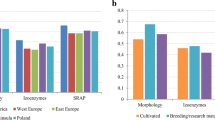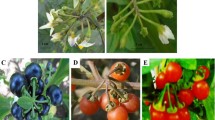Abstract
Artemisia umbelliformis Lam. (syn. A. mutellina Vill., A. laxa (L.) Fritsch) is an herbaceous alpine plant belonging to the Asteraceae family, and most commonly growing in the wild at altitudes between 2,000 and 3,700 m a.s.l. Its flowers are used for the production of an alcohol-based infusion called genepì in Italian and génépi in French. Uncontrolled picking of natural populations has endangered the species’ survival, despite bans in Switzerland and Italy and strict regulation in France. Limited quantities are produced under cultivation, but these are insufficient to meet market needs, so the selection of productive genotypes is a present priority. We report here an AFLP-based assessment of the genetic diversity represented in five ecotypes (Valle Gesso, Marmora, Gran Paradiso, Val Chisone and Elva), one selection (RAC12) and a wild population. The four ecotypes Valle Gesso, Gran Paradiso, Val Chisone and Elva together captured a broad coverage of the genetic variability present. A sample of ten plants was selected from each of these ecotypes for a more detailed analysis of genetic, phenological and morphological variation. The assays confirmed the distinctness of the four ecotypes, and were used to identify set of mother plants of clonal populations suitable for cultivation.





Similar content being viewed by others
References
Anderson JA, Churchill GA, Autrique JE, Tanksley SD, Sorells ME (1993) Optimizing parental selection for genetic-linkage maps. Genome 36(1):181–186
Appendino G, Belliardo F, Nano GM, Stefanelli S (1982) Sesquiterpene lactones from Artemisia genipi Weber: isolation and determination in plant material and in liqueurs. J Agric Food Chem 30:518–521
Appendino G, Cavallo L, Filippi S, Fontana E, Nicola S, Rubiolo P, Rebuffo M, Soster M, Tamietti G, Tibaldi G, Valentino D (2010) Il genepì—zone vocate—varietà—coltivazione—trasformazione. Quaderni della Regione Piemonte Agricoltura Supplemento 69:1–31
Bamoniri A, Mirjalili BBF, Mazoochi A, Batooli H (2010) Chemical composition of Artemisia vulgaris L. from Kashan area isolated by nano scale injection. Iran J Org Chem 2(4):533–536
Bewley JD (1997) Seed germination and dormancy. Plant Cell 9:1055–1066
Blagojević P, Radulović N, Palić R, Stojanović G (2006) Chemical composition of the essential oils of serbian wild-growing Artemisia absinthium and Artemisia vulgaris. J Agric Food Chem 54:4780–4789
Cavallo L, Turchi A, Levo T (2006) Dossier genepi. Una coltivazione interessante per molte aree montane. A tutto campo–Agricoltura e montagna in Provincia di Torino. Inserto 1:1–16
D’Andrea S, Caramiello R, Ghignone S, Siniscalco C (2003) Systematic studies on some species of the genus Artemisia: biomolecular analysis. Plant Biosyst 137(2):121–130
Dragland S, Senoo S, Wake K, Holte K, Blomhoff R (2003) Several culinary and medicinal herbs are important sources of dietary antioxidants. J Nutr 133(5):1286–1290
EC (1994) 94/358/EC: Council Decision of 16 June 1994 accepting, on behalf of the European Community, the Convention on the elaboration of a European Pharmacopoeia. O J 25/06/1994 L158:17–18
EC (2008) Regulation (EC) No 110/2008 of the European Parliament and of the Council of 15 January 2008 on the definition, description, presentation, labelling and the protection of geographical indications of spirit drinks and repealing Council Regulation (EEC) No 1576/89. Off J Eur Union L39:16–54
EC (2008) Regulation (EC) No 1334/2008 of the European Parliament and of the Council of 16 December 2008 on flavourings and certain food ingredients with flavouring properties for use in and on foods and amending Council Regulation (EEC) No 1601/91, Regulations (EC) No 2232/96 and (EC) No 110/2008 and Directive 2000/13/EC (Text with EEA relevance). Off J Eur Union L354:34–50
EEC (1988) Council Directive No 88/388/EEC of 22 June 1988 on the approximation of the laws of the Member States relating to flavourings for use in foodstuffs and to source materials for their production. O J 15/07/1988 L184:61–70
Erschbamer B, Retter V (2004) How long can glacier foreland species live? Flora 199:500–504
Felsenstein J (1993) PHYLIP, Phylogenetic Inference Package, Version 3.5.7, Department of Genetics, University of Washington, Seattle, WA. http://evolution.genetics.washington.edu/phylip.html
Fernández ME, Figueiras AM, Benito C (2002) The use of ISSR and RAPD markers for detecting DNA polymorphism, genotype identification and genetic diversity among barley cultivars with known origin. Theor Appl Genet 104:845–851
Govindaraj S, Ranjitha Kumari BD, Cioni PL, Flamini G (2008) Mass propagation and essential oil analysis of Artemisia vulgaris. J Biosci Bioeng 105(3):176–183
Jaccard P (1908) Nouvelles recherches sur la distribution florale. Bull Soc Vaud Sci Nat 44(163):223–270
Jackson JA, Matthews D (2000) Modified inter-simple sequence repeat PCR protocol for use in conjunction with the LI-COR gene ImagIR2 DNA analyzer. Biotechniques 28(5):914–920
Jerkovic I, Mastelic J, Milos M, Juteau F, Masotti V, Viano J (2003) Chemical variability of Artemisia vulgaris L. essential oils originated from the Mediterranean area of France and Croatia. Flavour Fragr J 18:436–440
Lachenmeier DW, Nathan-Maister D, Breaux TA, Sohnius E-M, Schoeberl K, Kuballa T (2008) Chemical composition of vintage preban absinthe with special reference to thujone, fenchone, pinocamphone, methanol, copper, and antimony concentrations. J Agric Food Chem 56:3073–3081
Lanteri S, Saba E, Cadinu M, Mallica GM, Baghino L, Portis E (2004) Amplified fragment length polymorphism for genetic diversity assessment in globe artichoke. Theor Appl Genet 108:1534–1544
Lopes-Lutz D, Alviano DS, Alviano CS, Kolodziejczyk PP (2008) Screening of chemical composition, antimicrobial and antioxidant activities of Artemisia essential oils. Phytochemistry 69:1732–1738
Menon AN, Padmakumari KP (2005) Essential oil composition of four major cultivars of black pepper (Piper nigrum L.). J Essent Oil Res 17:206–208
Milbourne D, Meyer R, Bradshaw JE, Baird E, Bonar N, Provan J, Powell W, Waugh R (1997) Comparison of PCR-based marker systems for the analysis of genetic relationships in cultivated potato. Mol Breed 3:127–136
Milhau G, Valentin A, Benoit F, Mallié M, Bastide J-M, Pélissier Y, Bessière J–M (1997) In vitro antimalarial activity of eight essential oils. J Essent Oil Res 9:329–333
Nei M (1973) Analysis of gene diversity in subdivided populations. Proc Natl Acad Sci USA 70(12):3321–3323
Nei M (1987) Molecular evolutionary genetics. Columbia University Press, New York
Nicola S, Saglietti D, Hoeberechts J, Fontana E (2003) La coltivazione di piante officinali in Piemonte Situazione attuale e prospettive. Quaderni della Regione Piemonte, Agricoltura 38:22–25
Portis E, Acquadro A, Comino C, Mauromicale G, Saba E, Lanteri S (2005) Genetic structure of island populations of wild cardoon [Cynara cardunculus L. var. sylvestris (Lamk) Fiori] detected by AFLPs and SSRs. Plant Sci 169:199–210
Powell W, Morgante M, Andre C, Hanafey M, Vogel J, Tingey S, Rafalski A (1996) The comparison of RFLP, RAPD, AFLP and SSR (microsatellite) markers for germplasm analysis. Mol Breed 2:225–238
Prevost A, Wilkinson MJ (1999) A new system of comparing PCR primers applied to ISSR fingerprinting of potato cultivars. Theor Appl Genet 98:107–112
Rey C, Slacanin I (1997) Domestication du genépi blanc. Rev Suisse Vitic Arboric Hortic 29(3):1–7
Rey C, Mercanti B, Bondaz F, Bonfanti R, Lini U, Piotti S, Piantini U, Gaillard F, Theodoloz G, Grogg A-F (2002) Projet interrégional sur la culture du genépi blanc. Rev Suisse Vitic Arboric Hortic 34(5):325–337
Rohlf FJ (2000) NTSYS, Numerical Taxonomy and Multivariate analysis System, vers. 2.1. Exeter Software—Applied Biostatistic Inc., NY
Rubiolo P, Matteodo M, Bicchi C, Appendino G, Gnavi G, Bertea C, Maffei M (2009) Chemical and biomolecular characterization of Artemisia umbelliformis Lam., an important ingredient of the Alpine Liqueur “genepì”. J Agric Food Chem 57:3436–3443
Sneath PHA, Sokal RR (1973) Numerical taxonomy: the principles and practice of numerical classification. W.H. Freeman, San Francisco, p 573
Snedecor GW, Cochran WG (1989) Statistical methods. The Iowa State University Press Publishing, New York
Tibaldi G, Fontana E, Nicola S (2010) Cultivation practices do not change the Salvia sclarea L. essential oil but drying process does. J Food Agric Environ 8(3, 4):790–794
Vekemans X, Beauwens T, Lemaire M, Roldan-Ruiz I (2002) Data from amplified fragment length polymorphism (AFLP) markers how indication of size homoplasy and a relationship between degree of homoplasy and fragment size. Mol Ecol 11:139–151
Vos P, Hogers R, Bleeker M, Reijans M, van de Lee T, Hornes M, Frijters A, Pot J, Peleman J, Kuiper M, Zabeau M (1995) AFLP: a new technique for DNA fingerprinting. Nucleic Acids Res 23:4407–4414
Wang J, Zhu F, Zhou XM, Niu CY, Lei CL (2006) Repellent and fumigant activity of essential oil from Artemisia vulgaris to Tribolium castaneum (Herbst) (Coleoptera: tenebrionidae). J Stored Prod Res 42:339–347
Wogiatzi E, Papachatzis A, Kalorizou H, Chouliara A, Chouliaras N (2011) Evaluation of essential oil yield and chemical components of selected basil cultivars. Biotechnol & Biotechnol Equip 25(3):2525–2527
Author information
Authors and Affiliations
Corresponding author
Additional information
Cinzia Comino and Giuseppe Pignata have contributed equally to this work.
Rights and permissions
About this article
Cite this article
Comino, C., Pignata, G., Portis, E. et al. Selection in Artemisia umbelliformis Lam. Piedmont ecotypes to improve cultivation in alpine environment. Genet Resour Crop Evol 62, 567–577 (2015). https://doi.org/10.1007/s10722-014-0182-6
Received:
Accepted:
Published:
Issue Date:
DOI: https://doi.org/10.1007/s10722-014-0182-6




